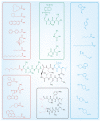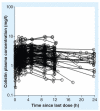Pharmacology of polymyxins: new insights into an 'old' class of antibiotics
- PMID: 23701329
- PMCID: PMC3852176
- DOI: 10.2217/fmb.13.39
Pharmacology of polymyxins: new insights into an 'old' class of antibiotics
Abstract
Increasing antibiotic resistance in Gram-negative bacteria, particularly in Pseudomonas aeruginosa, Acinetobacter baumannii and Klebsiella pneumoniae, presents a global medical challenge. No new antibiotics will be available for these 'superbugs' in the near future due to the dry antibiotic discovery pipeline. Colistin and polymyxin B are increasingly used as the last-line therapeutic options for treatment of infections caused by multidrug-resistant Gram-negative bacteria. This article surveys the significant progress over the last decade in understanding polymyxin chemistry, mechanisms of antibacterial activity and resistance, structure-activity relationships and pharmacokinetics/pharmacodynamics. In the 'Bad Bugs, No Drugs' era, we must pursue structure-activity relationship-based approaches to develop novel polymyxin-like lipopeptides targeting polymyxin-resistant Gram-negative 'superbugs'. Before new antibiotics become available, we must optimize the clinical use of polymyxins through the application of pharmacokinetic/pharmacodynamic principles, thereby minimizing the development of resistance.
Figures




References
-
- Infectious Diseases Society of America The 10 × ‘20 Initiative: pursuing a global commitment to develop 10 new antibacterial drugs by 2020. Clin. Infect. Dis. 2010;50(8):1081–1083. - PubMed
-
- Talbot GH, Bradley J, Edwards JE, Jr, Gilbert D, Scheld M, Bartlett JG. Bad bugs need drugs: an update on the development pipeline from the Antimicrobial Availability Task Force of the Infectious Diseases Society of America. Clin. Infect. Dis. 2006;42(5):657–668. - PubMed
-
- Payne DJ, Gwynn MN, Holmes DJ, Pompliano DL. Drugs for bad bugs: confronting the challenges of antibacterial discovery. Nat. Rev. Drug Discov. 2007;6(1):29–40. - PubMed
-
- Yong D, Toleman MA, Giske CG, et al. Characterization of a new metallo-beta-lactamase gene, bla(NDM-1), and a novel erythromycin esterase gene carried on a unique genetic structure in Klebsiella pneumoniae sequence type 14 from India. Antimicrob. Agents Chemother. 2009;53(12):5046–5054. - PMC - PubMed
Publication types
MeSH terms
Substances
Grants and funding
LinkOut - more resources
Full Text Sources
Other Literature Sources
Medical
Research Materials
